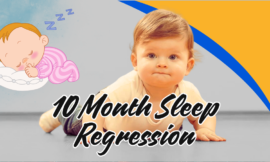The 3 month sleep regression is a common phase that many parents face as their babies grow and develop. It can be an exhausting and frustrating time, especially if your baby was previously sleeping well and suddenly starts waking up more often, having difficulty falling asleep, or becoming more fussy during nap and bedtime routines.
In this post, we’ll explore everything you need to know about the 3 month sleep regression, including the signs to look for, the causes behind it, and 5 proven strategies to help your baby (and you) get through this challenging period with better sleep.
1. What Is the 3 Month Sleep Regression?
The 3 month sleep regression is a temporary but often difficult phase where your baby’s sleep patterns become disrupted. Around the 3-month mark, many babies experience changes in their sleep due to developmental milestones, growth spurts, or changes in their brain activity.
While it’s common for babies to experience some sleep disturbances during their first year, the 3 month sleep regression can come as a surprise for parents, particularly if their baby was previously sleeping through the night or waking up less frequently. During this period, babies may wake up more often, have shorter naps, and struggle with falling asleep.
Why Does It Happen?
The 3 month sleep regression typically occurs because your baby’s brain and body are undergoing rapid growth. At this stage, babies are learning new skills, such as smiling, recognizing faces, and even beginning to roll over. These developmental leaps can lead to sleep interruptions as your baby’s brain processes all these new experiences.
2. Top 5 Signs Your Baby Is Experiencing the 3-Month Sleep Regression
Not sure if your baby is going through the 3 month sleep regression? Here are the top 5 signs to look out for:
1. Frequent Night Wakings
- If your baby suddenly starts waking up multiple times during the night after previously having longer stretches of sleep, this is one of the most common signs of sleep regression. These wakings may be due to developmental changes or increased hunger.
2. Shorter Naps
- A baby who used to take longer naps may now start waking up after just 20-30 minutes. This is because your baby is learning to transition between sleep cycles, and during the 3 month regression, they may have difficulty staying asleep.
3. Increased Fussiness
- Babies going through the 3 month sleep regression often become more fussy, especially during bedtime or nap time. This increased fussiness can make it harder to calm your baby and get them to settle into sleep.
4. Difficulty Falling Asleep
- You may notice that it takes much longer to get your baby to fall asleep, even if they seem tired. This could be due to your baby’s brain being more active as they develop new skills and go through growth spurts.
5. Changes in Feeding Patterns
- Some babies may start feeding more frequently during the night, which can disrupt their sleep. This is often related to a growth spurt that coincides with the 3 month sleep regression.
If your baby is showing these signs, it’s likely that they’re experiencing the 3 month sleep regression. The good news is that it’s temporary, and with the right approach, you can help your baby through this phase.
3. What Causes the 3 Month Sleep Regression?
Understanding the causes of the 3 month sleep regression can help you better navigate this challenging phase. Here are some of the most common factors behind this sleep disruption:
1. Developmental Milestones
At around 3 months, babies experience rapid brain development, which allows them to learn new skills, such as:
- Improved vision and the ability to recognize faces
- Smiling and responding to sounds
- Rolling over or increased movement
These milestones can lead to sleep disturbances as your baby’s brain processes all the new information.
2. Changes in Sleep Cycles
By 3 months, your baby’s sleep cycles are starting to mature, transitioning from newborn sleep patterns to more adult-like sleep. This means that they may begin to wake up more frequently between sleep cycles as they learn to connect those cycles.
3. Growth Spurts
Babies often go through a growth spurt at around 3 months, which can increase their hunger and lead to more frequent night feedings. This can disrupt sleep patterns as babies wake up more often to feed and satisfy their growing needs.
4. Increased Awareness
At 3 months, babies are becoming more aware of their surroundings, which can lead to overstimulation. This newfound awareness can make it harder for babies to settle down and fall asleep, especially in busy or noisy environments.
Understanding these causes can help you address the 3 month sleep regression with a proactive approach, knowing that your baby’s body and brain are developing rapidly.
4. How Long Does the 3 Month Sleep Regression Last?
The 3 month sleep regression can last anywhere from 2 to 6 weeks, depending on the baby. While this may seem like a long stretch, it’s important to remember that sleep regression is a temporary phase.
The duration of the regression depends on several factors, including:
- Your baby’s developmental milestones
- How quickly your baby adapts to changes in their sleep cycles
- Whether any other growth spurts or developmental changes occur during this time
During this period, it’s important to stay consistent with your baby’s sleep routines and provide them with comfort as they adjust to their new sleep patterns.
5. How to Handle the 3 Month Sleep Regression: Tips for Tired Parents
While the 3 month sleep regression can be tough, there are strategies you can use to help manage it and improve your baby’s sleep patterns. Here are 5 proven tips to help you navigate this phase:
1. Stick to a Consistent Sleep Routine
- A consistent bedtime routine can help signal to your baby that it’s time for sleep. Whether it’s a bath, reading a book, or singing a lullaby, sticking to the same sequence every night can help soothe your baby and make it easier for them to settle.
2. Encourage Self-Soothing
- Around 3 months, babies can start learning how to self-soothe. This doesn’t mean letting your baby cry it out, but rather giving them a few moments to try and settle themselves before you step in. Using a comfort object, like a soft blanket or pacifier, can help them feel secure.
3. Adjust Feeding Times
- If your baby is waking up more often to feed, try to ensure they’re getting enough nutrition during the day. You can also offer a dream feed just before you go to bed to help them sleep longer through the night.
4. Create a Sleep-Friendly Environment
- Make sure your baby’s sleep environment is conducive to rest. This includes:
- Keeping the room dark with blackout curtains
- Using a white noise machine to drown out any disruptive sounds
- Ensuring the room is at a comfortable temperature
5. Be Patient and Flexible
- The 3 month sleep regression is a challenging time, but it’s important to stay patient. Babies are learning to adjust to new developmental changes, and with time, they will return to more regular sleep patterns. If your baby’s sleep struggles persist, you may want to consult your pediatrician to rule out any underlying issues.
6. Sleep Regression vs Growth Spurt: Understanding the Difference
Parents often wonder whether their baby is experiencing a sleep regression or a growth spurt. While the two can happen simultaneously, there are distinct differences between them.
Sleep Regression
- Typically lasts 2-6 weeks
- Caused by developmental changes and disruptions in sleep cycles
- Results in frequent night wakings, fussiness, and difficulty falling asleep
Growth Spurt
- Lasts only a few days
- Causes increased hunger, leading to more frequent feedings
- May also result in longer naps or deeper sleep after feeding
If your baby is waking up more frequently to feed, they could be going through a growth spurt, but if they’re having trouble staying asleep or settling down, it’s likely a sleep regression.
Conclusion: How to Navigate the 3 Month Sleep Regression and Encourage Better Sleep
The 3 month sleep regression can be a difficult phase for both parents and babies, but it’s important to remember that it’s only temporary. With a consistent bedtime routine, a sleep-friendly environment, and patience, you can help your baby adjust to these changes and return to more restful sleep.
By understanding the causes behind the 3 month sleep regression and using the strategies outlined above, you can get through this challenging time and help your baby develop healthier sleep habits.
FAQs About the 3 Month Sleep Regression
- What is the 3 month sleep regression?
- The 3 month sleep regression is a temporary disruption in a baby’s sleep patterns due to developmental milestones, changes in sleep cycles, and growth spurts.
- What are the signs of 3 month sleep regression?
- Common signs include frequent night wakings, shorter naps, increased fussiness, and difficulty falling asleep.
- How long does the 3 month sleep regression last?
- The 3 month sleep regression typically lasts between 2 to 6 weeks, depending on the baby’s development.
- What causes sleep regression at 3 months?
- Causes include developmental milestones, changes in sleep cycles, increased awareness of surroundings, and growth spurts.
- How can I help my baby sleep better during the 3 month sleep regression?
- To help your baby sleep better, try maintaining a consistent bedtime routine, creating a sleep-friendly environment, and encouraging self-soothing.
- Is sleep regression the same as a growth spurt?
- No, sleep regression is caused by developmental changes, while a growth spurt typically leads to more frequent feeding but lasts only a few days.
- What can I do if my baby’s sleep regression lasts longer than 6 weeks?
- If the regression lasts longer than 6 weeks, it’s a good idea to consult your pediatrician to rule out any underlying sleep issues.
- Can sleep regression happen more than once?
- Yes, sleep regressions can happen at multiple stages during a baby’s first year, including at 4 months, 6 months, and 12 months.
- Does sleep regression affect naps?
- Yes, during the 3 month sleep regression, babies may take shorter naps or have difficulty settling down for naps.
- Is it normal for a baby to feed more during sleep regression?
- Yes, many babies experience increased hunger during sleep regressions, especially if they’re going through a growth spurt at the same time




